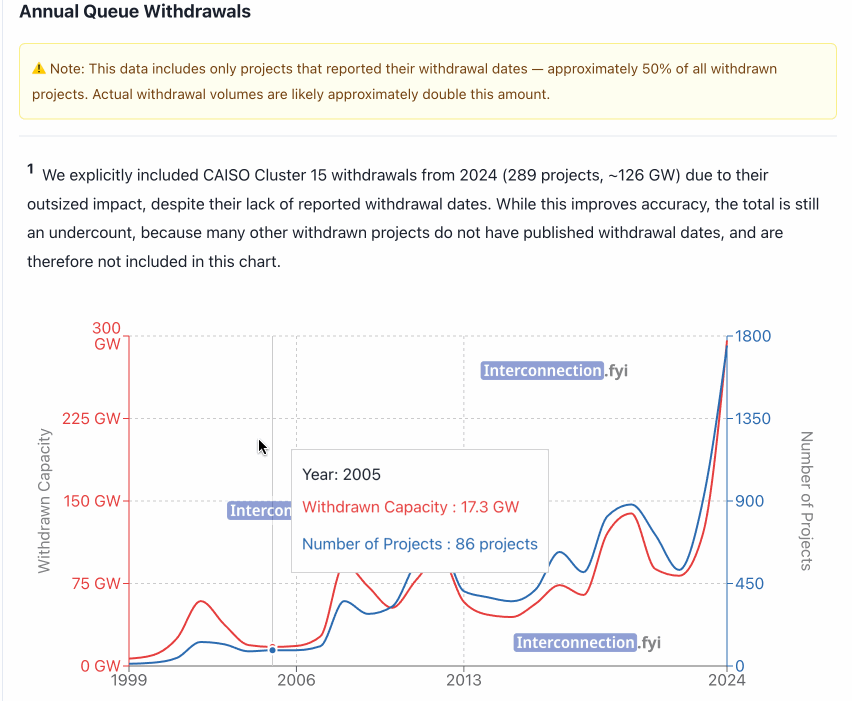In 2024, interconnection queues shrank for the first time in years
The Interconnection.fyi team dug into our historical data to see what happened in 2024, and one thing is clear: this was a year for interconnection queues unlike any other in recent history.
👉 Check out the full analysis here for interactive charts and more data.
In 2024, interconnection queues across the U.S. shrank — not because demand disappeared, but because the rules changed.
Many speculative projects were cleared out en masse this year, leaving behind a sharper, more committed pipeline.
Regional Capacity Changes (2023 → 2024)
The interconnection.fyi team went digging through our historical dataset to see how active queue volumes have shifted year-over-year — and for the first time in recent memory, they're shrinking.
The chart below compares 2023 vs. 2024 cumulative active capacity by fuel type and planning region, comparing snapshots taken at the end of each year. It reflects only projects that remained active at the end of each year, excluding anything withdrawn, completed, or otherwise removed from the queue. Green bars indicate an increase from 2023 to 2024; red bars represent a decrease.
That sea of red? It's not what we're used to seeing.
For years, active queue volumes grew at a breakneck pace — fueled by a surge of solar, wind, and storage projects. But in 2024, that trend reversed. Offshore wind fell by over 50%, solar dropped nearly 12%, and hybrid storage declined by nearly 20%.
So what changed?
Most signs point to queue reform. Over the past 18 months, ISOs like PJM, MISO, and CAISO implemented new rules requiring higher deposits, stricter site control, and milestone-based study processes. On top of that, FERC Order 2023 — while not yet fully implemented — means that these changes are here to stay. The one major exception? ERCOT, which isn't subject to FERC rules and continues to operate under its own policies.
One notable exception to the contraction trend was MISO, which saw a significant increase in queued capacity across nearly every fuel type. At first glance, this might seem to contradict the broader story — but it likely reflects a timing artifact, not a structural break.
MISO's queue was largely frozen in 2023 as it transitioned to a new interconnection process. When it reopened in early 2024, a wave of new applications entered — potentially representing deferred demand from developers waiting on clarity around the new rules. In this light, MISO's growth doesn't undermine the queue reform hypothesis — it just reflects how differently that transition played out across regions.
It's too early to tell if this is a lasting correction or a temporary reset — but 2024 marks a clear turning point in the evolution of interconnection queues.
While some of the recent decline in active queue capacity might be attributed to fewer new applications, that's not the whole story. In fact, 2024 saw a massive spike in project withdrawals. Among projects with reported withdrawal dates (which is only about half of all withdrawn projects), plus withdrawals from CAISO cluster 15[1], 296 GW of capacity was withdrawn from the queues last year — more than double the amount withdrawn in 2023, and by far the largest annual total in the dataset.
The number of individual projects withdrawn also surged, jumping 96% year-over-year. This points to a broader structural shift: queue reform processes are not just filtering future applicants — they're forcing existing projects out. The bottleneck isn't closing at the entrance; it's clearing out the middle.
Queue Timelines (2023 → 2024)
How long does it take to get through the queue?
To answer that, we analyzed the time between a project's interconnection request and its eventual commercial operation date (COD). For each power market, we calculated the median and interquartile range (25th to 75th percentile) of queue-to-COD durations for projects that reached COD in a given year.
These charts reveal that typical development timelines remain stubbornly long — often 3 to 5 years — with wide variability depending on the market. Some regions like PJM and the Southeast show relatively consistent durations, while others like SPP display more volatility and longer median timelines. Nationally, there's no clear evidence yet that queue reform efforts have meaningfully shortened the path to COD.
Note: ERCOT and NYISO are excluded from this analysis due to insufficient historical data for meaningful timeline comparisons. Including ERCOT would likely decrease the median timeline.
Note: These figures likely undercount the total number of projects reaching COD each year, as we can only include projects that report their actual commercial operation dates in interconnection queue data.
Withdrawal Timelines (2023 → 2024)
What about the projects that didn't make it?
To better understand the other side of queue attrition, we looked at how long withdrawn projects had been sitting in the queue before exiting. For each power market, we measured the time between a project's interconnection request and its withdrawal, and calculated the median and interquartile range for projects withdrawn in a given year.
The picture that emerges is just as striking. In 2024, many withdrawn projects had been in the queue for 4 to 5 years — a meaningful amount of time for developers to invest before walking away. In markets like CAISO, the median project sat in the queue for over 5.4 years before withdrawing. PJM, Southeast, and MISO show slightly shorter timelines, but still hover around the 3–4 year mark.
Importantly, this analysis includes only the roughly 50% of withdrawn projects that report a withdrawal date. While incomplete, we believe the trend is representative; these aren't just speculative applications disappearing overnight. In many cases, they're projects that stuck it out for several years before ultimately exiting, likely due to delays, reform-driven barriers, or shifting market conditions.











